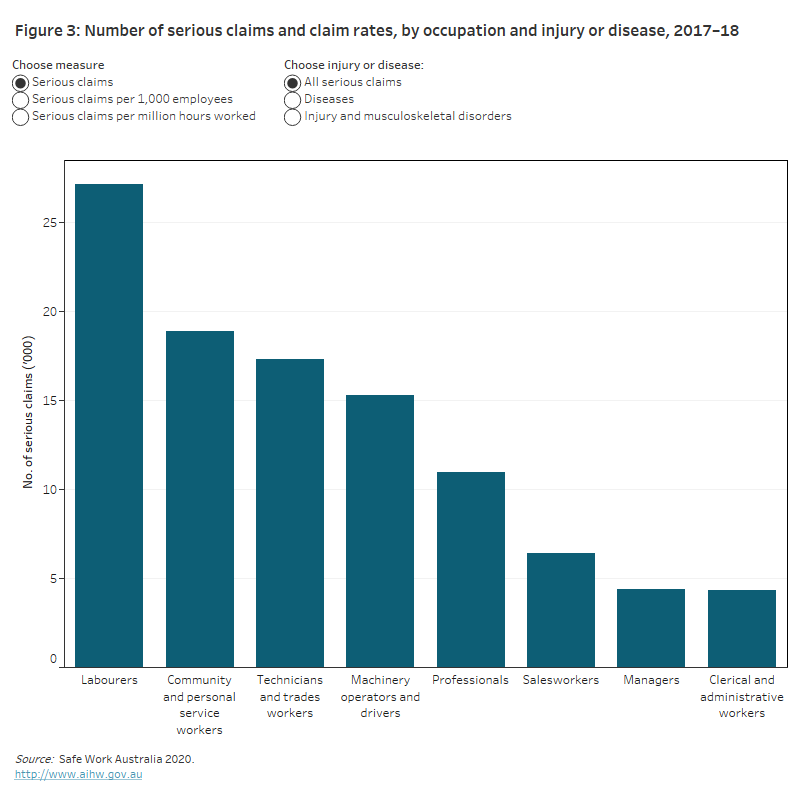How Much Of The Population Uses Worker's Compensation Services
There were 563,600 total workplace injuries or illnesses in Commonwealth of australia in 2017–eighteen, downward from 689,500 in 2005–06. Information technology too shows that the proportion of all employees who worked in 2017–18 that experienced a work-related injury or disease was 4.2%, downwards from 6.iv% in 2005–06.
Visualisation non bachelor for printing
In 2016–17, there were 9.one serious claims per 1,000 employees and v.v serious claims per million hours worked, which has been a consistent downward trend from xvi.3 and nine.v, respectively, in 2000–01.

In 2017–18, labourers had the highest frequency rate and full number of serious claims overall. For affliction-related claims, however, community and personal service workers had the highest frequency rate and total number of serious claims. Sales workers, managers, and clerical and authoritative workers had the lowest rate and full number of serious claims overall.

Type of injuries or diseases
In 2017–18, 89% of serious claims were for injury and musculoskeletal disorders (Safety Work Australia 2020). The remaining serious claims were for diseases, including mental health atmospheric condition (7.five% of total serious claims), digestive system diseases (ane.9%) and nervous systems and sense organ diseases (one.0%).
Overall, 41% of claims were for traumatic joint/ligament and muscle/tendon injury, followed by wounds, lacerations, amputations and internal organ damage (16%) and musculoskeletal and connective tissue diseases (xiv%). Fractures accounted for eleven% of serious claims, and mental health atmospheric condition 7.5%.
In 2017–18, labourers (25,055 serious claims) and community and personal service workers (xvi,560 serious claims) accounted for the highest number of injuries and musculoskeletal disorders (Figure 3). Community and personal service workers (two,335) and professionals (2,245 serious claims) accounted for the highest number of disease-related serious claims.
Run across Health expenditure.
Costs
Work-related injuries, diseases and deaths are costly to employers, workers and their communities.
In 2017–xviii, $1.viii billion was spent through workers' compensation agencies for work-related injuries and diseases (AIHW 2019). This was an increase of iii.7% since 2016–17, which was higher than the average annual growth rate over the decade of ane.3%.
In 2016–17, a median time of five.3 weeks of work was lost for serious claims in the injury and musculoskeletal disorder grouping, and ten.2 weeks for diseases (Safety Work Australia 2020). Adjusting for changes in the price of labour (base year 2000–01), the median compensation paid in 2016–17 was $7,100.
Of all types of injuries and diseases, mental health conditions resulted in the highest median time off work (17.iii weeks) and the highest median compensation paid ($xxx,800). Injuries to the nerves and spinal cord had the next highest median time off work (10.eight weeks), and were the next most plush at $21,100, after 'other diseases' ($22,000).
Where practise I go for more information?
For more than information on workers' compensation, see:
- Safe Work Commonwealth of australia Australian Workers' Compensation Statistics
- Australian Agency of Statistics Work-Related Injuries, Australia, Jul 2017 to Jun 2018
- Health expenditure Australia 2017–18
References
ABS (Australian Agency of Statistics) 2019. Piece of work-Related Injuries, Australia, Jul 2017 to Jun 2018. ABS cat. no. 6324.0. Canberra: ABS.
AIHW (Australian Establish of Health and Welfare) 2019. Health expenditure Australia 2017–xviii. True cat. no. HWE 077. Canberra: AIHW.
Safe Work Commonwealth of australia 2018. Comparing of workers' bounty arrangements in Australia and New Zealand. Canberra: Safety Work Commonwealth of australia.
Safe Work Commonwealth of australia 2020. Australian Workers' Bounty Statistics 2017–2018. Canberra: Safe Work Commonwealth of australia.
How Much Of The Population Uses Worker's Compensation Services,
Source: https://www.aihw.gov.au/reports/australias-health/workers-compensation
Posted by: lamarchetwoment.blogspot.com


0 Response to "How Much Of The Population Uses Worker's Compensation Services"
Post a Comment